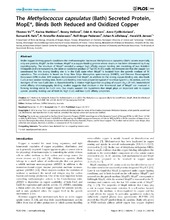| dc.contributor.author | Ve, Thomas | eng |
| dc.contributor.author | Mathisen, Karina | eng |
| dc.contributor.author | Helland, Ronny | eng |
| dc.contributor.author | Karlsen, Odd André | eng |
| dc.contributor.author | Fjellbirkeland, Anne | eng |
| dc.contributor.author | Røhr, Åsmund K. | eng |
| dc.contributor.author | Andersson, K. Kristoffer | eng |
| dc.contributor.author | Pedersen, Rolf Birger | eng |
| dc.contributor.author | Lillehaug, Johan | eng |
| dc.contributor.author | Jensen, Harald B. | eng |
| dc.date.accessioned | 2013-01-23T14:23:51Z | |
| dc.date.available | 2013-01-23T14:23:51Z | |
| dc.date.issued | 2012-08-20 | eng |
| dc.Published | PLoS ONE 7(8): e43146 | eng |
| dc.identifier.issn | 1932-6203 | en_US |
| dc.identifier.uri | https://hdl.handle.net/1956/6288 | |
| dc.description.abstract | Under copper limiting growth conditions the methanotrophic bacterium Methylococcus capsulatus (Bath) secrets essentially only one protein, MopE*, to the medium. MopE* is a copper-binding protein whose structure has been determined by X-ray crystallography. The structure of MopE* revealed a unique high affinity copper binding site consisting of two histidine imidazoles and one kynurenine, the latter an oxidation product of Trp130. In this study, we demonstrate that the copper ion coordinated by this strong binding site is in the Cu(I) state when MopE* is isolated from the growth medium of M. capsulatus. The conclusion is based on X-ray Near Edge Absorption spectroscopy (XANES), and Electron Paramagnetic Resonance (EPR) studies. EPR analyses demonstrated that MopE*, in addition to the strong copper-binding site, also binds Cu(II) at two weaker binding sites. Both Cu(II) binding sites have properties typical of non-blue type II Cu (II) centres, and the strongest of the two Cu(II) sites is characterised by a relative high hyperfine coupling of copper (A | en_US |
| dc.description.abstract | = 20 mT). Immobilized metal affinity chromatography binding studies suggests that residues in the N-terminal part of MopE* are involved in forming binding site(s) for Cu(II) ions. Our results support the hypothesis that MopE plays an important role in copper uptake, possibly making use of both its high (Cu(I) and low Cu(II) affinity properties. | en_US |
| dc.language.iso | eng | eng |
| dc.publisher | Public Library of Science (PLoS) | en_US |
| dc.rights | Attribution CC BY | eng |
| dc.rights.uri | http://creativecommons.org/licenses/by/2.0/ | eng |
| dc.subject | X-ray Near Edge Absorption spectroscopy | eng |
| dc.subject | EPR spektroskopi | eng |
| dc.subject | EPR spectroscopy | eng |
| dc.subject | Kopperprotein | eng |
| dc.subject | Copperprotein | eng |
| dc.subject | Proteinstruktur | eng |
| dc.subject | Protein structure | eng |
| dc.title | The Methylococcus capsulatus (Bath) Secreted Protein, MopE*, Binds Both Reduced and Oxidized Copper | en_US |
| dc.type | Peer reviewed | |
| dc.type | Journal article | |
| dc.description.version | publishedVersion | en_US |
| dc.rights.holder | Copyright 2012 Ve et al. | en_US |
| dc.source.articlenumber | e43146 | |
| dc.identifier.doi | https://doi.org/10.1371/journal.pone.0043146 | |
| dc.identifier.cristin | 936058 | |
| dc.source.journal | PLoS ONE | |
| dc.source.40 | 7 | |
| dc.source.14 | 8 | |

